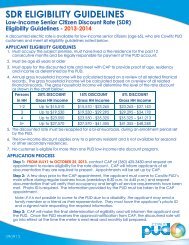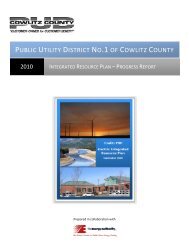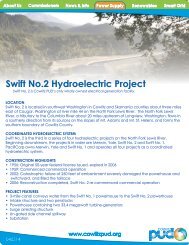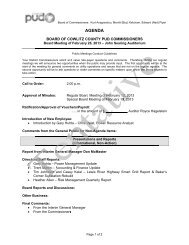- Cowlitz PUD
- Cowlitz PUD
- Cowlitz PUD
You also want an ePaper? Increase the reach of your titles
YUMPU automatically turns print PDFs into web optimized ePapers that Google loves.
Chapter 5: ConservationConservation Resources<strong>Cowlitz</strong> <strong>PUD</strong> has been actively engaged in energy efficiency and demand-sidemanagement for over 26 years and it plans to continue these efforts. Since1981, <strong>PUD</strong> programs have cumulatively acquired over 24 aMW of conservationresources. The <strong>PUD</strong> offers education services, financial incentives, applianceand heat pump rebates, and customized programs to all customer segments.<strong>Cowlitz</strong> <strong>PUD</strong> recently signed an agreement with a professional firm to develop aConservation Resource Potential Plan that meets the requirements ofWashington State RCW Chapter 19.285, Energy Independence Act (I-937), andRCW Chapter 19.280, Electric Utility Resource Plans (HB1010). These newlaws require reporting and documenting amounts of conservation and efficiencyresources that utilities plan to achieve. The Energy Independence Act requiresutilities to establish conservation targets beginning in 2010 and then documenthow the targets are achieved. Each biennial target must be achieved to avoid apenalty. In general, the Conservation Resource Potential Plan will provide utilityspecifictargets, quantified conservation projections, costs and benefits.Another change that is occurring impacts Bonneville Power Administration (BPA)customers, like <strong>Cowlitz</strong> <strong>PUD</strong>. BPA is changing its rate structure from a meldedrate system to a two-tiered rate schedule. Tier 1 rates will be established basedon the cost of the Federal Base System (FBS), but the energy quantity will belimited to the output capability of the current FBS resources. Tier 2 rates areavailable to utilities with requirements above Tier 1 eligible power, but these ratesare reflective of the open market cost for BPA to acquire new resources to servethe added load. BPA utility customers can choose to pay the higher Tier 2 rates,build their own resources, develop conservation, or purchase on the openmarket. Conservation, when viewed as a resource and compared alongsidetraditional supply-side resources, can be significantly less expensive than marketrates. Increasing the amount of conservation in our service territory will benefitratepayers and mesh well with our portfolio of power resources.Developing an effective energy efficiency strategy is very important under thenew regulatory requirements and provides positive economic benefits. Projectedfuture conservation energy savings (NWPPC targets) were incorporated in theIRP analysis as a load reduction to the District’s load forecast. In future studiesthe District expects to use the results of the Conservation Resource PotentialPlan currently under development.The District’s current conservation programs consist of seven residentialprograms and four programs targeted towards the commercial and industrialsectors. A brief description of the current programs follows:46








